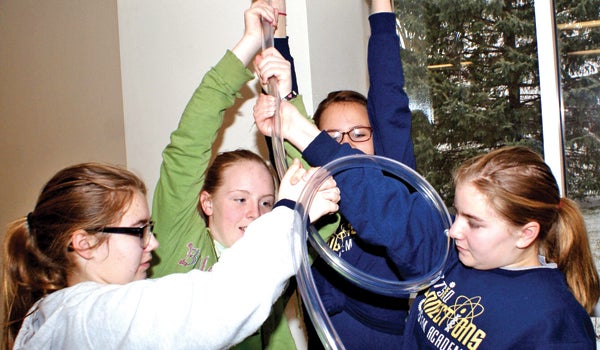Eastside experiments with roller coasters, DNA at SMC
Published 9:43 am Thursday, March 23, 2017
Southwestern Michigan College Physics Professor Andrew Dohm uses roller coasters with Niles’ Eastside Connections School, a New Tech partner devoted to project-based learning.
Next door in the William P.D. O’Leary science building March 17, Biology Professor Deirdre Kurtis conducts a DNA necklace exercise with another group of students.
“A lot of mechanical engineering goes on” around roller coasters, Dohm said. “We have to know about energy and motion to design a roller coaster that functions properly and doesn’t make people sick. The body can only withstand certain amounts of force. I have a cousin-in-law who flies F-15 Eagles for the Air Force. They have to wear special suits to do maneuvers that keep blood from pooling in their legs.”
Dohm draws back a huge rubber band as “an example of stored energy. Potential energy is like a bank account, storing for later use. This rubber band didn’t stretch itself. Something had to provide energy input for it to be stored. Once we release it, that energy can create motion.”
“Potential energy (PE) and kinetic energy (KE) — the energy of motion — are two principles we spend a lot of time talking about in physics,” Dohm said. “Those are referred to as mechanical energy. We can also talk about energy conservation — preserving it.”
“There’s a law,” Dohm said, “that says energy can neither be created or destroyed, it just changes forms. Energy is everywhere. As engineers and physics students, we study how to change energy back and forth to different forms to do useful things.
“Roller coasters depend a lot on these two kinds of energy. The cars need to be pulled to the top of the first hill, which is the same idea as stretching the rubber band. When it gets to the top of the hill, it has a lot of potential energy. Gravitational potential energy is due to an elevated position in the earth’s gravitational field. Gravity takes over when you release it. PE turns into KE. It’s a teeter-totter balancing act between two energies.”
They rub their hands together to demonstrate “friction creates heat and robs mechanical systems of energy,” Dohm said, pouring water from one cup to another.
“The bus you rode couldn’t get here if there wasn’t friction between the tires and the road,” he said. “You have to factor in friction on roller coasters — not only cars on the track, but air resistance, too.”
They experiment by dropping ball bearings through flexible plastic tubing at different angles.
Kurtis, meanwhile, has made her own acronym for deoxyribonucleic acid, the molecule that carries genetic instructions used in growth, development, functioning and reproduction of all known living organisms and many viruses.
For purposes of her extraction exercise, DNA stands for Detergent eNzymes (meat tenderizer) and Alcohol.
Cells from the lining of the mouth come loose easily, so students collect cells containing DNA by swishing Gatorade around in their mouths.
They add a small amount of detergent to a test tube to coat the bottom. Putting a glove on the hand holding the test tube, they pour the drink containing cheek cells into the detergent test tube until it is half full.
They add a pinch of meat tenderizer to the test tube. With their gloved thumb or palm covering the test tube, they invert it five times to mix, then let the mixture sit for 10 minutes in the rack and color a DNA diagram on the back of their lab sheet while they wait (red phosphates, blue deoxyriboses, orange thymines, green adenines, purple guanines and yellow cytosines).
Using pipettes, they slowly add cold rubbing alcohol to the test tube, drizzling it down the size so it forms a layer on top of the soapy liquid. They add alcohol until they have 2 cm in the tube. Alcohol is less dense than water, so it floats on top.
They place test tubes in the rack without mixing or bumping for 10 minutes.
DNA molecules clump together where soapy water below meets the cold alcohol above.
These DNA clumps appear as white strands floating in the alcohol layer.
Pipettes suck up DNA from the test tube to transfer it to a small capped tube, filled the rest of the way with alcohol. Closing the cap of the tube around a piece of string leaves them with necklaces of their own DNA.







